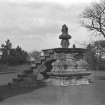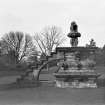Scheduled Maintenance
Please be advised that this website will undergo scheduled maintenance on the following dates: •
Tuesday 3rd December 11:00-15:00
During these times, some services may be temporarily unavailable. We apologise for any inconvenience this may cause.
Dundas Castle, Fountain And Sundial
Fountain (17th Century), Sundial (17th Century)
Site Name Dundas Castle, Fountain And Sundial
Classification Fountain (17th Century), Sundial (17th Century)
Alternative Name(s) Dundas Castle Policies
Canmore ID 50559
Site Number NT17NW 6.03
NGR NT 11875 76697
Datum OSGB36 - NGR
Permalink http://canmore.org.uk/site/50559
- Council Edinburgh, City Of
- Parish Dalmeny
- Former Region Lothian
- Former District City Of Edinburgh
- Former County West Lothian
NT17NW 6.03 11875 76697
(NT 1184 7674) Fountain and Dial (1623) (NAT)
OS 6" map (1856)
Immediately E of Dundas Castle is a fine fountain surmounted by a sundial. The fountain has been removed from another part of the grounds and no longer plays. The frieze bears a lengthy inscription in Latin which records that the dial was erected by Sir Walter Dundas in 1623. RCAHMS 1929, visited 1926
This fountain and sundial is now located at NT 1187 7670.
Visited by OS (JLD) 31 December 1952
NMRS REFERENCE:
Dr Thomas Ross - manuscript notes on fountain and sundial
Scheduled with NT17NW 6.00 and 22 as Old Dundas Castle, castle, sundial and dovecot.
Information from Historic Scotland, scheduling document dated 3 March 1999.
NMRS REFERENCE:
Following information from Dr AR Somerville, Mendota, Middlewood Road, Higher Poynton, Cheshire in letter 08.08.1989
'I also visited Dundas Castle again and this time was allowed to climb the steps of the fountain to inspect the dial closely. To my mind it sits rather uneasily on the top basin of the fountain, with the jets hard up against it so that their pattern would have been spoilt, and there are no water marks on the dial as one might have expected if the dial had been in place when the fountain was operating. This suggests to me that the dial was not part of the original structure but was added later when the fountain had ceased to be operational. However, the Latin inscription on the fountain dated 1623 undoubtedly mentions the dial, though if one reads it carefully it does not necessarily imply that it was an integral part of the fountain; it could merely have been one of the other furnishings of the garden. And of course it need not necessarily have been the dial which is present now. This makes one think again about the chronology of these dials; the Dundas lectern is usually regarded as the earliest 'symbolic' or 'Masonic' dials because of the 1623 date on the fountain but it has always seemed to me to be a bit out on a limb because the next one does not come until 1644* and it would make a neater story if the fashion started with John Mylne at Drummond Castle in 1630, Holyrood 1633 and Stobhall about 1642'.
















